Whatever Became of Hawaii’s First Test Tube Baby?
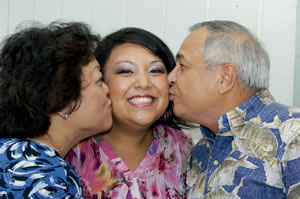
Janice and James Low have always showered Jacquelyn with love. Nathalie Walker photo nwalker@midweek.com
By CHRIS FLECK
Her birth was historic, but since then Jacquelyn Low’s life has been pretty normal, just as her parents wished
Every loving woman or couple who wishes to have the joy of raising and developing a child under their care and affection should have the opportunity to do so. Sometimes, however, certain biological circumstances hinder that ability, leaving couples saddened and distraught.
Twenty-five and a half years ago in 1985, Janice and James Low personified those feelings of frustration. And then a revolutionary new procedure, brought to their attention through a simple print advertisement, changed everything, including the laws of infertility. The Lows went from frustrated to blessed – the blessing being the miracle of their daughter Jacquelyn.
On Dec. 20, 1985, an early Christmas present, Jacquelyn Low was the first baby born in Hawaii by means of in vitro fertilization, following the world’s first, Louise Brown, who was born in 1978 in Oldham, England, and the United States’ first, Elizabeth Carr, born in 1981.
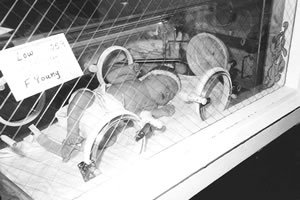
Healthy 7 1/2 pound Jacquelyn Low hours after her birth
“I had complications from an appendix removal, and the doctors had to take one of my fallopian tubes, and they knew the other one was infected,” says Janice. “After corrective surgery, I had to wait three years, and after those three years from the heavens came the doctors of Pacific In Vitro Fertilization. We were interested and we gave it a try.”
In vitro fertilization, which is described as conception, is early embryo growth outside of the body. IVF is a procedure by which the eggs of a healthy woman – who must have a uterus and at least one ovary – are removed and fertilized in a laboratory. Up to 50,000 healthy sperm are then injected into each egg, creating zygotes. Once the zygotes begin to cellularly divide, embryos are formed. Three days after the egg retrieval has taken place, doctors transfer the embryos back into the uterus of the potential mother.
A common misperception is that babies born by IVF are products of test tubes, referred to as “test tube babies.” The reality is the egg fertilization procedures are conducted in petri dishes. Once the laboratory-created embryos are transferred back into the uterus, the waiting game of early pregnancy begins.
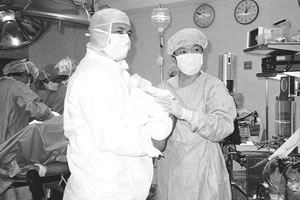
James Low (left) holds his new born daughter Jacquelyn. Photos courtesy Low family
“Once a woman becomes pregnant by IVF, it is basically the same as if she had gotten pregnant by intercourse or artificial insemination. There is no increased risk of abnormal babies or of miscarriage,” says Pacific In Vitro Fertilization director Dr. Carl Morton.
A series of blood tests are conducted to monitor the progression of the pregnancy. If blood tests gradually come back positive, the hopeful mothers will have their first ultrasound exam. PIVF laboratory director Dr. Thomas Huang was working very closely with Janice Low’s laboratory fertilization in 1985.
“I remember seeing the lab sheet that came back with the beta eggs she gave us from the pregnancy hormone tests showing positives,” says Huang. “That was a day I’ll never forget.”
For Janice, it was the doctors of PIVF who made what was a tumultuous, anxious pregnancy experience a bit easier. As the first in vitro pregnancy in Hawaii, Janice says she was not treated normally by the original PIVF doctors, who included Thomas Kosasa, Philip McNamee, Francis Terada, Benton Chun. and Huang.
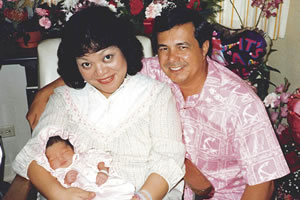
Baby Jacquelyn with proud parents Janice and James
“When I had to go to the emergency room for labor, I remember Dr. Kosasa was on call and he asked everyone else not to touch me. I was a little special, they were extra cautious with me,” recalls Janice.
As IVF was such an radical procedure, that caution would remain even after healthy, 7 1/2-pound Jacquelyn was born.
So she certainly has an exceptional answer to the question, “Where do babies come from?”
Jacquelyn’s earliest memory surrounding her birth and in vitro fertilization was at a party held at Washington Place that celebrated the first 100 IVF babies born in Hawaii.
“I remember I was really young at the governor’s mansion, and a television reporter asking me what the party was for and I responded, ‘Test tube baby,’ so I have known for a while,” says Jacquelyn.
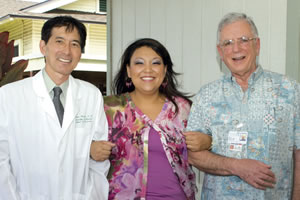
(from left) Dr. Thomas Kosasa, Jacquelyn Low and Dr. Carl Morton. Nathalie Walker photo nwalker@midweek.com
She also had to get used to the hovering from her parents and doctors.
“They were so overbearing, all of them,” she adds with a laugh. “The doctors would call me at night to make sure I went to sleep.”
Jacquelyn has grown to understand that the caution and protectiveness was out of love. For many women and couples who choose to have an IVF procedure, it is usually their last chance of getting pregnant, so when it is successful, the emotions run extra high.
“When we had our first 100 babies party at the governor’s mansion, I know for a fact that every single set of parents was very special. There was no yelling or screaming. No threatening or spanking,” says Morton. “It was an absolute love fest toward the kids, and I think that is true with all IVF babies.”
Although showered with love from day one, Jacquelyn does admit there is a certain sense of pressure or expectation for IVF babies.

The Star-Bulletin’s Page 1 story told the happy news
“If you think about all the success and failure talk about having a baby on that level, you have to think about how we feel as the baby. It is a lot of pressure, because all we want to do is make them happy – they brought life to us,” she says.
Janice and James only want the best for Jacquelyn, and she continues to make them proud. She graduated from Iolani, then continued her education, graduating in 2008 from University of Oregon with a bachelor’s degree in business administration and a minor in Chinese. In August, Jacquelyn will move to Guangzhou, China, for one year to study through UH Manoa’s Shidler Business School’s MBA program.
Just as Jacquelyn is coming of age, maturing before her parents’ eyes, the developments of in vitro fertilization have been vastly improving over the past 25 years. The IVF procedure has since become much easier on women. What used to be a laparoscopic procedure conducted under general anesthesia, which required some recovery time, is now a general out-patient procedure with women being released only hours after their eggs are removed.
“Back in the ’80s the woman had to stay flat on her back, tilted backwards. We’ve learned a lot more about the conditions of the eggs and embryos and what they need to develop, so I would say the dramatic changes have been in the laboratory,” says Huang.
Success rates of IVF are usually determined by the age of the patient, with women under the age of 35 having a more successful chances of pregnancy because of the quality of their eggs. In the ’80s, the success rates was about 20 percent. Now those percentages are around 50 percent. That may not sound like a significantly high percentage, but to many infertile women faith can be found in even a 1 percent chance.
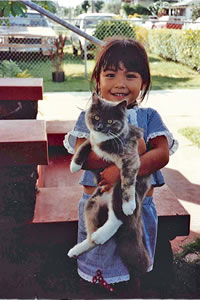
Jacquelyn at age 5. Photo courtesy Low family
Collaboratively working with Galileo Research Laboratories, an international consulting group, as well as Dr. Yanagimachi and many other doctors and students at UH Manoa’s Institute for Biogenesis Research, developments in Advanced Reproductive Technology (ART) Services are constantly evolving. Specifically, procedures in egg freezing now give women a chance to freeze their unfertilized eggs for when they are more prepared for pregnancy. This procedure also is extremely important to women who may have to undergo certain cancer treatments that could compromise their egg quality. Intracytoplasmic Sperm Injection, or ICSI, is another revolutionary change developed to help couples with severe male factor infertility. Financially, steps are being taken, giving patients the means to follow through with IVF procedures. In 1987, a Hawaii state law mandated that any insurance that covers obstetrical care must cover one attempt by IVF.
As the first, Jacquelyn Low is a story of personal accomplishment and continuing success. But this also is a story of hope and possibility for all women and couples who have that yearning to bring their own child into our world, surrounding a young baby girl or boy with love, guidance and security.



